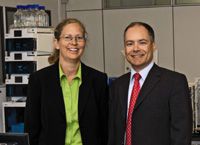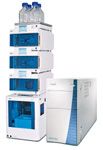KNAUER
KNAUER develops and manufactures chromatography instrumentation for use in laboratories for tasks such as identification, quantification, and isolation of the components of liquids with complex composition.
Company Description
KNAUER develops and manufactures chromatography instrumentation for use in laboratories for tasks such as identification, quantification, and isolation of the components of liquids with complex composition. To be at the service of the customer has always been a central idea at KNAUER — in this way the company has earned a reputation for delivering high-quality, easy-to-use instruments at a reasonable price. The family-owned business is today managed by Alexandra Knauer, daughter of founder Dr. Herbert Knauer. Ms. Knauer, together with Managing Director Dr. Alexander Bünz, sets the course of the company and continues the tradition of innovation.

Chief Chromatographic Techniques Supported
- Ultra high-performance liquid chromatography (UHPLC)
- Analytical and preparative HPLC
- Biochromatography
- Simulated moving bed (SMB) chromatography
- Automated sample preparation
Markets Served
KNAUER HPLC systems and columns are used in research and development, quality control, and production plant laboratories around the world. Customers are typically governmental and industrial organizations as well as universities. Fields of application include pharmaceutical and medical research, analysis of foodstuffs and petrochemicals, as well as environmental analysis. KNAUER also manufactures most of its product range for numerous OEM partners.
Major Products/Services
- PLATINblue – HPLC/UHPLC product line for higher productivity and reduced cost per sample compared to conventional HPLC. The modular product line covers one of the widest flow rate ranges (max. 1000 bar, up to 2 ml/min; 800 bar up to 5 ml/min; 400 bar up to 10 ml/min) for applications ranging from standard HPLC to high-resolution UHPLC and can be combined with various sensitive and fast detectors including MS.
- Smartline – modular instruments for the conventional HPLC range feature a very small footprint and outstanding specifications. Their reliability, flexible upgradeability, and service-friendly design keep customers' costs to a minimum.
- Bioline – biochromatography solutions with high resolution glass columns, appropriate stationary phases, and biocompatible LC systems with a unique benchtop cooling feature.
- Preparative HPLC – instruments for reliable value product purification at flow ranges up to 1000 ml/min.
- SMB – simulated moving bed chromatography purification systems for smaller-scale production plants, e.g. in the pharmaceutical industry. Since 2007 KNAUER has partnered with Illinois-based company Asahi Kasei TechniKrom, Inc. to offer customers larger scale solutions.
- HPLC columns – are available from narrow-bore to preparative scale. Stationary phases include silica-based Eurospher, Eurospher II, polymer-based Eurokat and polysaccharide-based Eurocel for chiral separations. The 1.8 µm BlueOrchid high-resolution LC columns feature a remarkably low back pressure.
- ChromGate® and ClarityChrom® – FDA 21 CFR Part 11 compliant data acquisition and instrument control software packages for automated solutions including preparative HPLC and sample preparation.
Facilities
A staff of 100 employees develops, manufactures, and markets the complete line of KNAUER instruments at the headquarters in Berlin, Germany. KNAUER products are distributed in more than 60 countries through a worldwide network of dealers which receive regular training in Berlin.

KNAUER
Hegauer Weg 38
14163 Berlin, Germany
TELEPHONE
+49 (0)30 809727-0
FAX
+49 (0)30 8015010
WEB SITE
NUMBER OF EMPLOYEES
100
YEAR FOUNDED
1962

Determining Enhanced Sensitivity to Odors due to Anxiety-Associated Chemosignals with GC
May 8th 2025Based on their hypothesis that smelling anxiety chemosignals can, like visual anxiety induction, lead to an increase in odor sensitivity, a joint study between the University of Erlangen-Nuremberg (Erlangen, Germany) and the Fraunhofer Institute for Process Engineering and Packaging (Freising, Germany) combined behavioral experiments, odor profile analysis by a trained panel, and instrumental analysis of odorants (gas chromatography-olfactometry) and volatiles (gas chromatography-mass spectrometry).
Investigating 3D-Printable Stationary Phases in Liquid Chromatography
May 7th 20253D printing technology has potential in chromatography, but a major challenge is developing materials with both high porosity and robust mechanical properties. Recently, scientists compared the separation performances of eight different 3D printable stationary phases.
Detecting Hyper-Fast Chromatographic Peaks Using Ion Mobility Spectrometry
May 6th 2025Ion mobility spectrometers can detect trace compounds quickly, though they can face various issues with detecting certain peaks. University of Hannover scientists created a new system for resolving hyper-fast gas chromatography (GC) peaks.

.png&w=3840&q=75)

.png&w=3840&q=75)



.png&w=3840&q=75)



.png&w=3840&q=75)


















